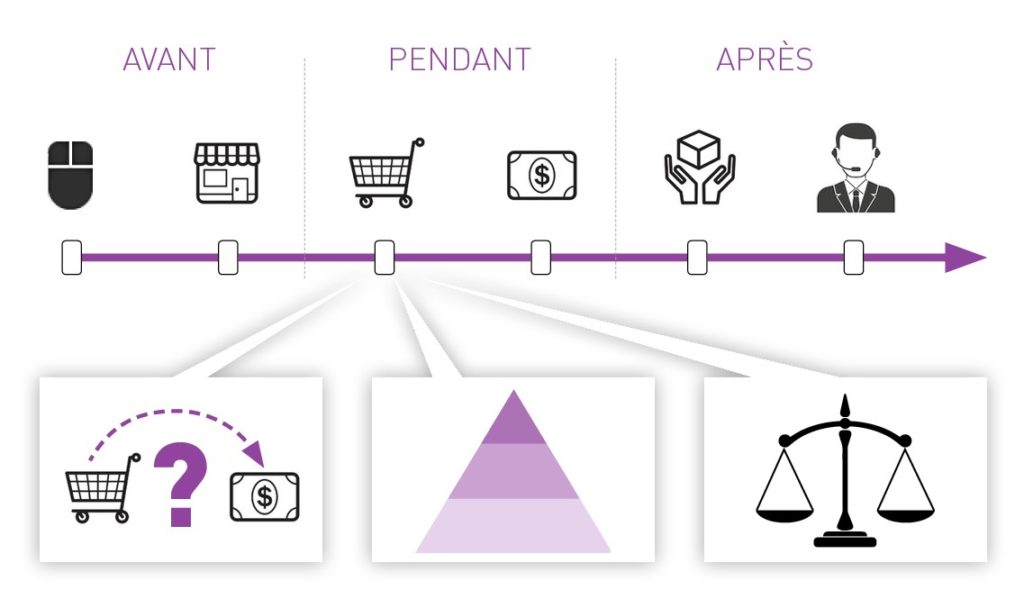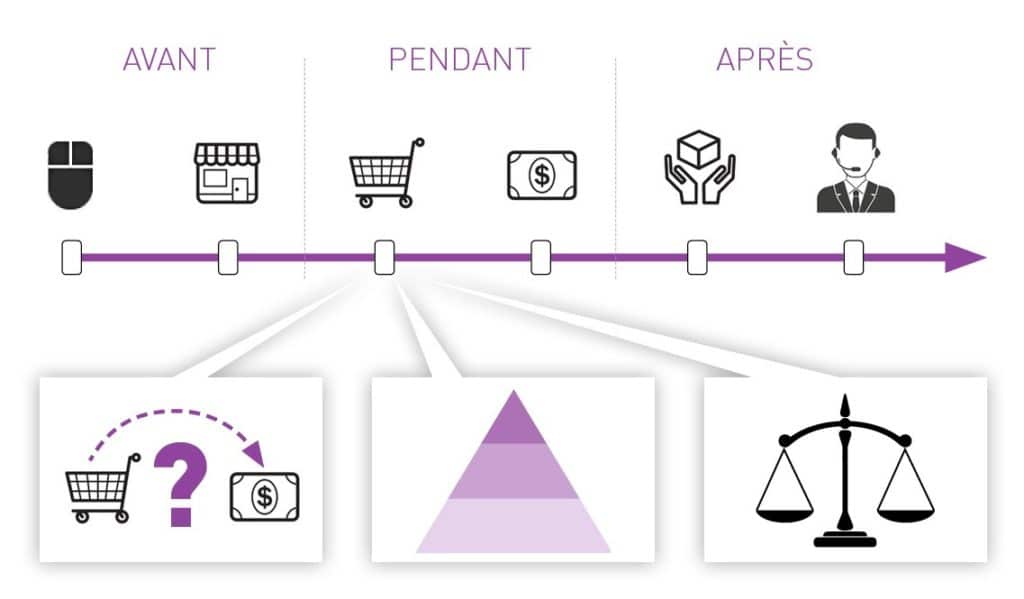(Si ce n’est pas encore le cas, nous invitons à redécouvrir les raisons pour lesquelles l’expérience client est un sujet stratégique et la façon dont l’enchantement client agit sur votre rentabilité !) Vous avez même probablement déjà une idée de l’expérience client cible que vous visez, une vision et une ambition en la matière… Mais savez-vous par où commencer pour l’atteindre ? Le point de départ de cette démarche consiste invariablement à définir et optimiser votre parcours client. Retour sur “les fondamentaux” du design et de l’évaluation de parcours client, base préalable à tout projet d’amélioration de l’expérience client.
1. Au fait, qu’est-ce que le Parcours Client ?
Le parcours client est l’ensemble des étapes et points d’interaction entre un client et une entreprise, depuis le début du processus d’achat jusqu’à la consommation complète du produit.
Pour simplifier, 3 grandes phases caractérisent ce parcours:

- AVANT : toutes les étapes préalables, depuis la prise de connaissance active ou passive de l’offre jusqu’au processus d’achat, en passant par la phase de décision d’achat
- PENDANT : le processus de « delivery » intégrant toutes les étapes de mise à disposition et de consommation ou d’utilisation du service ou du produit.
- APRES : Les processus d’après-vente, intégrant le service client, la mesure de la satisfaction client, et tout le processus relationnel permettant de garder le contact et de fidéliser le client.
L’enjeu est de fluidifier le passage en boucle de l’APRES à l’AVANT.
En ce sens, et même s’ils se chevauchent partiellement, le parcours client se différencie du cycle de vie client. Le cycle de vie est une observation bien plus macroscopique du passage successif de l’état de prospect à l’état de client actif jusqu’à l’état de client perdu. Il peut donc contenir plusieurs itérations du parcours client, voire plusieurs parcours en fonction du changement d’état du client.
2. A quoi sert la modélisation du parcours client ?
Dans une démarche d’amélioration de l’expérience client, modéliser le parcours client est la première étape nécessaire.
Cela permet de :
-
- recenser toutes les étapes du parcours et tous les points de contact entre le client et l’entreprise,
- déterminer l’importance de chaque point de contacts dans l’expérience client,
- d’évaluer le niveau de réponse de l’entreprise sur ces points de contact,
- de définir et mettre en œuvre les améliorations nécessaires par rapport au niveau de réponse ambitionné par l’entreprise.
Si cette approche a été déployée en premier lieu pour les entreprises du secteur BtoC, elle se réplique et s’adapte de plus en plus aux entreprises dans le BtoB.
3. Définir le parcours client
Il n’existe pas forcément un seul parcours client. Selon ses typologies de clientèle, l’entreprise peut proposer différents parcours client : c’est le cas par exemple desentreprises qui ont une clientèle intermédiée avec des distributeurs, des prescripteurs, des installateurs, et des consommateurs finaux, ou de celles qui veulent offrir un parcours très différent à leurs meilleurs clients.
Un point de contact se définit par une interaction entre le client et l’entreprise, via un canal déterminé, physique ou digital. L’interaction peut être de nature informative ou transactionnelle, et déclenchée soit par l’entreprise (push) soit par le client (pull).
C’est par exemple la lecture d’une publicité en ligne ou sur un magazine, un email promotionnel reçu, une visite sur le site web de l’entreprise, l’entrée dans un magasin, un appel du service client, la réception du colis, un email de confirmation de commande, la réception d’une facture, etc.
L’étape du parcours client n’est pas systématiquement liée à un point de contact. Elle peut être vécue dans le parcours du client sans interaction directe avec l’entreprise. C’est par exemple une recommandation par un tiers sur un réseau social, un déplacement et un mode de transport jusqu’à l’entreprise.
4. Evaluer le niveau d’importance de l’étape du parcours
Toutes les étapes ne sont pas égales dans l’expérience du client. On dit souvent que le premier et le dernier point de contact du parcours sont ceux qui forgent le plus le ressenti du client, qu’il soit positif ou négatif. Il y a aussi d’autres étapes, souvent les plus délicates, qui avec la première et la dernière impression laissées représentent les étapes clés.
On appelle « moments de vérité », ces étapes clés qui, selon la manière dont l’entreprise saura les traiter, peuvent faire basculer un client en un client fidèle… ou un client perdu.
L’enjeu est de satisfaire l’attente, voire de la dépasser, dans un moment critique pour le client.
Quelques exemples : la réception d’un colis, ou les modalités de retour pour une entreprise de e-commerce, la présentation de la facture pour un garage, l’accueil à l’arrivée pour un hôtel, la disponibilité du produit pour un magasin, la soutenance d’une proposition pour une société de service, l’accessibilité du service client pour une entreprise de transport, …
Le fait de couvrir de manière satisfaisante les attentes du client sur ces étapes constitue un point d’ancrage de la fidélisation. Le fait de ne pas les couvrir favorise le départ des clients
5. Evaluer le niveau de réponse aux attentes du client
Il est important d’évaluer le niveau de satisfaction délivré en tenant compte des attentes et des besoins des différents types de client. Parce que tous les clients ne sont pas identiques, il est nécessaire de détecter et créer des segments de client selon leurs attentes, voire pour certains secteurs d’activité d’aller jusqu’à la personnalisation du parcours.

Une famille n’a pas les mêmes besoins qu’un couple dans une station de ski, un bricoleur amateur n’a pas les mêmes attentes qu’un professionnel dans chez un marchand d’outillage, une PME n’a pas les mêmes attentes dans sa gestion de flotte automobile chez un loueur.
Il est également essentiel de réfléchir sur une dimension multicanale du parcours, en respectant le choix des clients dans le canal ou les canaux préférés ou privilégiés, et dans une dimension « omnicanale » du parcours, permettant à un client de poursuivre son expérience client sans rupture, en toute fluidité sur l’ensemble des canaux relationnels et auprès de tous les interlocuteurs de l’entreprise
Sur l’ensemble des étapes du parcours et plus particulièrement sur les moments de vérité, nous aidons les entreprises à mesurer leur niveau de réponse aux attentes de leurs clients, afin de définir de façon efficace et pertinente les actions à mettre en oeuvre pour améliorer et fluidifier le parcours et générer de l’enchantement.
La méthode WelcomeExperience® proposée par KESTIO permet de
– définir les parcours client multicanaux
– évaluer la criticité des points d’interaction
– évaluer le niveau de satisfaction délivré
afin d’élaborer un plan effectif d’amélioration de l’expérience client.





